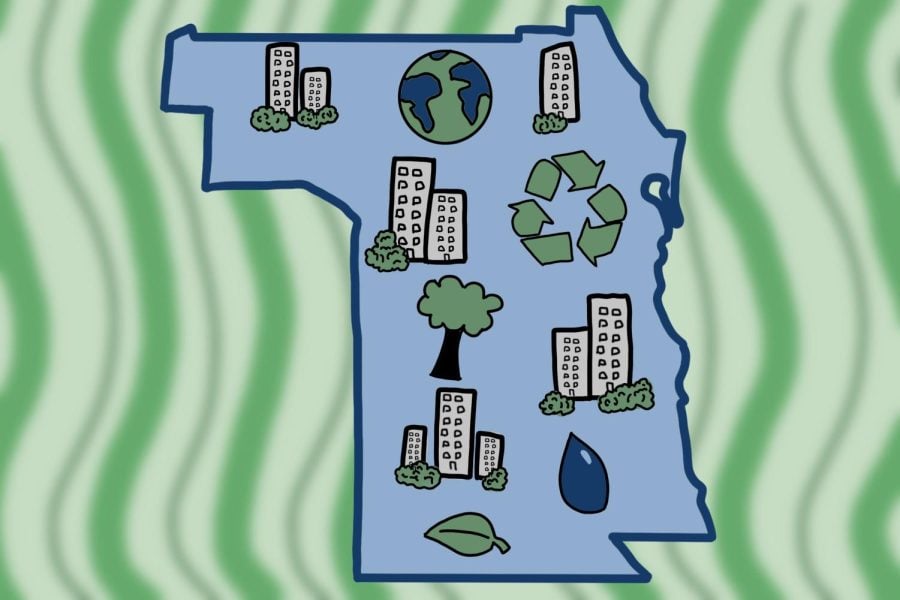As Evanston moves toward sustainability, local activists criticize slow pace of change
Evanston aims to be carbon neutral by 2050. But activists say the city must work faster to be able to reach this goal.
May 25, 2023
For many environmental activists in Evanston, their greatest priority involves meeting the goals set out in the Climate Action and Resilience Plan first approved by the city in 2018.
The plan calls for a severe reduction in carbon emissions, achieving carbon neutrality by 2050 and securing 100% renewable energy for all Evanston properties by 2030.
According to Cara Pratt, the city’s sustainability and resilience manager, Evanston has seen almost zero reductions in natural gas emissions in the past 20 years.
In the past two decades, the city has explored multiple options for sustainability. In 2009, the city passed a Green Building Ordinance to increase energy efficiency in Evanston buildings and facilities. Evanston also operates public electric vehicle charging stations throughout the city.
This April, Evanston relaunched its Sustain Evanston Incentive Program, which provides grants of up to $25,000 to select businesses looking to pursue a sustainable project. Initially rolled out in 2019, the program aims to reward green businesses.
Evanston has reduced its emissions by 38% since 2005, according to Pratt –– in part by purchasing renewable energy credits. This approach allows the city to offset carbon emissions by purchasing renewable energy certificates from other states.
But, this approach has been criticized as indirect. Environmental activists argue credits do not add new renewable energy in Evanston, and some environmental experts have denounced the credits as a “scam.”
[Read more about the city’s approach to reducing emissions through renewable energy credits here.]
Jerri Garl, co-chair of Environmental Justice Evanston, described sustainability as a practice that is “communal, self-sufficient and in harmony with the environment.” She added growing local food and investing in clean energy can help forge sustainable futures.
“Everything in the world of sustainability is like a three-legged stool. It’s got environmental protection or environmental health. You got economic health, and you’ve got social equity,” Garl said. “All three of those aspects of sustainability have to be strong.”
According to Jack Jordan (Weinberg ’22), who authored an honors thesis on local climate activism in Evanston, resident activism has been the primary driver of sustainability initiatives in the city since the 1990s.
Citizen activism pushed environmental and energy policies forward for years, resulting in the first Evanston Climate Action plan in 2007 according to Jordan.
Jordan said the most promising update this year involved the addition of two full-time employees dedicated to sustainability and community outreach at the city’s Office of Sustainability, which previously had only a director.
For Jordan and many local environmental activists, Evanston has not made enough progress to meet its goals of 100% renewable energy goals in all of its buildings by 2030. In 2019, the city received 31% of its electricity from renewable sources and hopes to more than double that number to 75% by 2025, according to a 2019 city report.
Hal Sprague, a member of Climate Action Evanston, said the group — formerly called Citizens’ Greener Evanston — successfully pushed for the addition of a sustainability coordinator in 2007.
CGE also successfully advocated for the city to adopt a resolution declaring a climate emergency in 2022, joining over 2,000 jurisdictions worldwide.
Sprague added the most significant obstacle to achieving sustainability goals remains with changing individual behaviors relating to consumption and transportation habits, which can be difficult “even in a progressive place like Evanston.”.
Sprague said he, like Jordan, is concerned about the city’s lack of urgency and action to meet the goals outlined in CARP.
Pratt said her primary responsibility in city government is to implement CARP. She added the city is exploring intersections of sustainability with racial and economic equity, and is most proud of a sustainable housing initiative in the process of development.
That initiative received $1 million in funding from the American Rescue Plan Act last year and is currently conducting energy audits and examining potential properties to retrofit into green affordable housing. Applications for building renovations will open by the end of the year, according to Pratt.
“It addresses the energy burden and environmental justice and focuses on providing solutions to our lowest income residents to improve the health of their homes,” she said.
Jordan said substantial improvement in energy policy must occur by 2030 if the city wants to reach its net zero carbon goal by 2050.
According to Sprague, the city should include transportation, food systems, energy efficiency and water use to capture a more holistic conception of sustainability.
“The thread of passion to make CARP work traversed time. Sustainability is primarily a climate issue, but it also involves all these other things that aren’t necessarily mentioned in CARP, like food,” Sprague said. “How can we make things last for the next seven generations, to make it sustainable forever?”
Email: [email protected]
Twitter: @JackAustinNews
Related Stories:
— CARP struggles to gain traction three years after its implementation
— Local activism plays key role in Evanston’s climate leadership, student thesis shows












